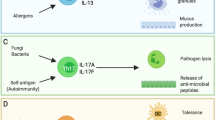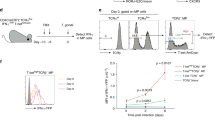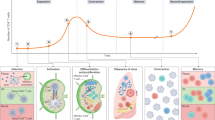Abstract
Plasmacytoid dendritic cells (PDCs) are a subset of dendritic cells present in human blood and inflamed lymph nodes. Here we show that blood PDCs, when stimulated with influenza virus and CD40L in vitro, undergo a maturation process characterized by up-regulation of major histocompatibility complex proteins and adhesion and costimulatory molecules. In addition, PDCs down-regulate CXCR3 and L-selectin, which mediate migration and homing of these cells into the lymph node. Mature PDCs efficiently stimulate T cells and drive a potent TH1 polarization in vitro, which is mediated by the synergistic effect of interleukin 12 and type I interferon. In vivo, mature PDCs are found in secondary lymphoid organs, where they represent the principal source of type I interferon during inflammation. Thus, PDCs probably participate in antiviral and pro-inflammatory responses, rather than in TH2 polarization and tolerance induction.
This is a preview of subscription content, access via your institution
Access options
Subscribe to this journal
Receive 12 print issues and online access
We are sorry, but there is no personal subscription option available for your country.
Buy this article
- Purchase on SpringerLink
- Instant access to full article PDF
Prices may be subject to local taxes which are calculated during checkout









Similar content being viewed by others
References
Steinman, R. M. The dendritic cell system and its role in immunogenicity. Annu. Rev. Immunol. 9, 271–296 (1991).
Banchereau, J. & Steinman, R. M. Dendritic cells and the control of immunity. Nature 392, 245– 252 (1998).
Sauter, B. M. et al. Consequences of cell death: exposure to necrotic tumor cells, but not primary tissue cells or apoptotic cells, induces the maturation of immunostimulatory dendritic cells. J. Exp. Med. 191 , 423–434 (2000).
Cyster, J. G. Chemokines and the homing of dendritic cells to the T cell areas of lymphoid organs. J. Exp. Med. 189, 447– 450 (1999).
Grouard, G., Durand, I., Filgueira, L., Banchereau, J. & Liu, Y. J. Dendritic cells capable of stimulating T cells in germinal centres. Nature 384, 364–367 (1996).
Bjorck, P., Flores-Romo, L. & Liu, Y. J. Human interdigitating dendritic cells directly stimulate CD40-activated naive B cells. Eur. J. Immunol. 27, 1266–1274 (1997).
O'Doherty, U. et al. Dendritic cells freshly isolated from human blood express CD4 and mature into typical immunostimulatory dendritic cells after culture in monocyte-conditioned medium. J. Exp. Med. 178, 1067–1076 (1993).
O'Doherty, U. et al. Human blood contains two subsets of dendritic cells, one immunologically mature and the other immature. Immunology 82, 487–493 (1994).
Grouard, G. et al. The enigmatic plasmacytoid T cells develop into dendritic cells with interleukin (IL)-3 and CD40-ligand. J. Exp. Med. 185, 1101–1111 (1997).
Olweus, J. et al. Dendritic cell ontogeny: a human dendritic cell lineage of myeloid origin. Proc. Natl Acad. Sci. USA 94, 12551–12556 (1997).
Strobl, H. et al. Identification of CD68+lin− peripheral blood cells with dendritic precursor characteristics. J. Immunol. 161, 740–748 (1998).
Cella, M. et al. Plasmacytoid monocytes migrate to inflamed lymph nodes and produce large amounts of type I interferon. Nature Med. 5, 919–923 (1999).
Robinson, S. P. et al. Human peripheral blood contains two distinct lineages of dendritic cells. Eur. J. Immunol. 29, 2769– 2778 (1999).
Ito, T. et al. CD1a+/CD11c+ subset of human blood dendritic cells is a direct precursor of Langerhans cells. J. Immunol. 163, 1409–1419 ( 1999).
Kohrgruber, N. et al. Survival, maturation, and function of CD11c− and CD11c+ peripheral blood dendritic cells are differentially regulated by cytokines. J. Immunol. 163, 3250–3259 (1999).
Vollenweider, R. & Lennert, K. Plasmacytoid T-cell clusters in non-specific lymphadenitis. Virchows Archiv. (Cell Pathol.) 44, 1–14 ( 1983).
Facchetti, F., De Wolf-Peeters, C., van den Oord, J. J., De vos, R. & Desmet, V. J. Plasmacytoid T cells: a cell population normally present in the reactive lymph node. An immunohistochemical and electron microscopic study. Hum. Pathol. 19, 1085 –1092 (1988).
Facchetti, F. et al. Plasmacytoid T cells. Immunohistochemical evidence for their monocyte/macrophage origin. Am. J. Pathol. 133, 15–21 (1988).
Girard, J. P. & Springer, T. A. High endothelial venules (HEVs): specialized endothelium for lymphocyte migration. Immunol. Today 16, 449–457 ( 1995).
Piali, L. et al. The chemokine receptor CXCR3 mediates rapid and shear-resistant adhesion-induction of effector T lymphocytes by the chemokines IP10 and Mig . Eur. J. Immunol. 28, 961– 972 (1988).
Farber, J. M. Mig and IP-10: CXC chemokines that _target lymphocytes. J. Leukoc. Biol. 61, 246–257 ( 1997).
Perussia, B., Fanning, V. & Trinchieri, G. A leukocyte subset bearing HLA-DR antigens is responsible for in vitro alpha interferon production in response to viruses. Nat. Immun. Cell Growth Regul. 4, 120– 137 (1985).
Chehimi, J. et al. Dendritic cells and IFN-α producing cells are two functionally distinct non-B, non-monocytic HLA-DR+ cell subsets in human peripheral blood. Immunology 68, 488– 490 (1989).
Fitzgerald-Bocarsly, P., Feldman, M., Mendelsohn, M., Curl, S. & Lopez, C. Human mononuclear cells which produce interferon-α during NK(HSV-FS) assays are HLA-DR positive cells distinct from cytolytic natural killer effectors. J. Leukoc. Biol. 43, 323–334 (1988).
Feldman, M. & Fitzgerald-Bocarsly, P. Sequential enrichment and immunocytochemical visualization of human interferon-α producing cells. J. Interferon Res. 10, 435– 446 (1990).
Fitzgerald-Bocarsly, P. Human natural interferon-α producing cells. Pharmacol. Ther. 60, 39–62 ( 1993).
Siegal, F. P. et al. The nature of the principal type 1 interferon-producing cells in human blood. Science 284, 1835– 1837 (1999).
Rissoan, M. C. et al. Reciprocal control of T helper cell and dendritic cell differentiation . Science 283, 1183–1186 (1999).
Liu, Y. J. & Blom, B. Introduction: Th2-inducing DC2 for immunotherapy. Blood 95, 2482– 2483 (2000).
Parronchi, P. et al. Effects of interferon-α on cytokine profile, T cell receptor repertoire and peptide reactivity of human allergen-specific T cells . Eur. J. Immunol. 26, 697– 703 (1996).
Rogge, L. et al. Selective expression of an interleukin-12 receptor component by human T helper 1 cells. J. Exp. Med. 185, 825–831 (1997).
Cella, M. et al. Maturation, activation, and protection of dendritic cells induced by double-stranded RNA. J. Exp. Med. 189, 821–829 (1999).
Arpinati, M., Green, C. L., Heimfeld, S., Heuser, J. E. & Anasetti, C. Granulocyte-colony stimulating factor mobilizes T helper 2-inducing dendritic cells. Blood 95, 2484–2490 (2000).
Trinchieri, G. Interleukin-12: a cytokine at the interface of inflammation and immunity. Adv. Immunol. 70, 83–243 (1998).
Gerosa, F. et al. CD4(+) T cell clones producing both interferon-gamma and interleukin-10 predominate in bronchoalveolar lavages of active pulmonary tuberculosis patients . Clin. Immunol. 92, 224– 234 (1999).
Groux, R. et al. A CD4+ T-cell subset inhibits antigen-specific T-cell responses and prevents colitis. Nature 389, 737– 742 (1997).
Gerosa, F. et al. Interleukin-12 primes human CD4 and CD8 T cell clones for high production of both interferon-γ and interleukin-10. J. Exp. Med. 183, 2559–2569 (1996).
Ridge, J. P., Di Rosa, F. & Matzinger, P. A conditioned dendritic cell can be a temporal bridge between a CD4+ T-helper and a T-killer cell. Nature 393, 474–478 (1998).
Facchetti, F. et al. Plasmacytoid monocytes (so-called plasmacytoid T cells) in granulomatous lymphadenitis. Hum. Pathol. 20, 588–593 (1989).
Facchetti, F., De Wolf-Peters, C., Marocolo, D. & De Vos, R. Plasmacytoid monocytes in granulomatous lymphadenitis and in histiocytic necrotizing lymphadenitis. Sarcoidosis 8, 170– 171 (1991).
Facchetti, F. et al. Expression of inducible nitric oxide synthase in human granulomas and histiocytic reactions. Am. J. Pathol. 154, 45–52 (1999).
Langenkamp, A., Messi, M., Lanzavecchia, A. & Sallusto, F. Kinetics of dendritic cell activation impacting on priming of TH1, TH2 and unpolarized T cells. Nature Immunol. 1, 311–316 (2000).
Iwasaki, A. & Kelsall, B. L. Freshly isolated Peyer's patch, but not spleen, dendritic cells produce interleukin 10 and induce the differentiation of T helper type 2 cells. J. Exp. Med. 190, 229–239 (1999).
Stumbles, P. A. et al. Resting respiratory tract dendritic cells preferentially stimulate T helper cell type 2 (Th2) responses and require obligatory cytokine signals for induction of Th1 immunity. J. Exp. Med. 188, 2019–2031 (1998).
Khanna, A. et al. Effects of liver-derived dendritic cell progenitors on Th1- and Th2-like cytokine responses in vitro and in vivo. J. Immunol. 164, 1346–1354 (2000).
Res, P. C., Couwenberg, F., Vyth-Dreese, F. A. & Spits, H. Expression of pTα mRNA in a committed dendritic cell precursor in the human thymus. Blood 94, 2647– 2657 (1999).
Steinman, M. R., Turley, S., Melmann, I. & Inaba, K. The induction of tolerance by dendritic cells that have captured apoptotic cells. J. Exp. Med. 191, 411–416 (2000).
Sallusto, F., Cella, M., Danieli, C. & Lanzavecchia, A. Dendritic cells use macropinocytosis and the mannose receptor to concentrate macromolecules in the major histocompatibility complex class II compartment: downregulation by cytokines and bacterial products. J. Exp. Med. 182 , 389–400 (1995).
Acknowledgements
We thank M. Dessing, T. Hayden and H. Kohler for cell sorting assistance; P. Lane, H. Gallati and I. Julkunen for reagents; M. Kopf, F. Sallusto and R. Ettinger for reading the manuscript. The Basel Institute for Immunology was founded and is supported by Hoffmann-La Roche Ltd, CH-4002 Basel. Part of these results were presented at the Workshop on Lymphoid Organogenesis held in Basel (November 5–6, 1999).
Author information
Authors and Affiliations
Corresponding author
Rights and permissions
About this article
Cite this article
Cella, M., Facchetti, F., Lanzavecchia, A. et al. Plasmacytoid dendritic cells activated by influenza virus and CD40L drive a potent TH1 polarization. Nat Immunol 1, 305–310 (2000). https://doi.org/10.1038/79747
Received:
Accepted:
Issue Date:
DOI: https://doi.org/10.1038/79747



